- How to Rot a Tree Stump Fast with Chemicals - December 8, 2023
- Portable Sawmill Rental Guide: Potential Rental Options - December 25, 2022
- Best 18 Inch Chainsaw Chains Worth Your Investment - December 19, 2022
If you’re new to woodworking, you probably have some questions about discerning between various forestry tools. Axes and Hatchets are two similar tools that are misunderstood and sometimes misused. That being said, it’s essential to know your craft and utilize them in the right circumstances to optimize any woodworking project. The axe & hatchet each have a rich history and both effectively cut through stubborn wood like butter.
These engaging tools require physical force to accomplish their purpose. You must put your heart into chopping wood with the proper technique, and different applications call for the right tools. Axes and Hatchets are used for chopping wood, but that doesn’t mean they’re interchangeable for any task.
Keeping both in your kit is ideal because you’ll be prepared for thicker or thinner branches, logs, and trees. Let’s chop through the details together to harness an understanding of the differences between hatchets and axes. You can make a sharper decision when choosing and equip yourself to handle mother nature’s challenges with modern tools!
Bottom Line Up Front
I firmly believe both are valuable additions to your toolset and have different uses depending on your wood chopping needs. An axe is a heavy-duty tool for chopping down thicker trees, giving you more control and force while using two hands.
A hatchet is utilized for lighter woodworking needs, but it’s still a wonderful tool used on small trees. They can be used for smaller firewood tasks, but an axe is better for felling large trees and thicker pieces of wood or logs.
Understanding their differences will give you insight into when they’re appropriately applied. This helps you remain safer and more competent when working while getting the most out of their intended design.
Main Differences Between Hatchet vs Axe
The main differences between Hatches vs Axe are:
- An axe is much larger and heavier, whereas a hatchet is smaller and lighter
- The handle of a hatchet is short, whereas the handle of an axe is longer
- An axe is harder to maneuver and requires greater strength, whereas a hatchet is easier to maneuver
- A hatchet can be wielded with more precision and less exertion, whereas an axe is meant for less precise chopping and felling
- You must use two hands with an axe, whereas you can use one with a hatchet
Axe vs Hatchet: Assessing The Challenges
Increasing Accuracy
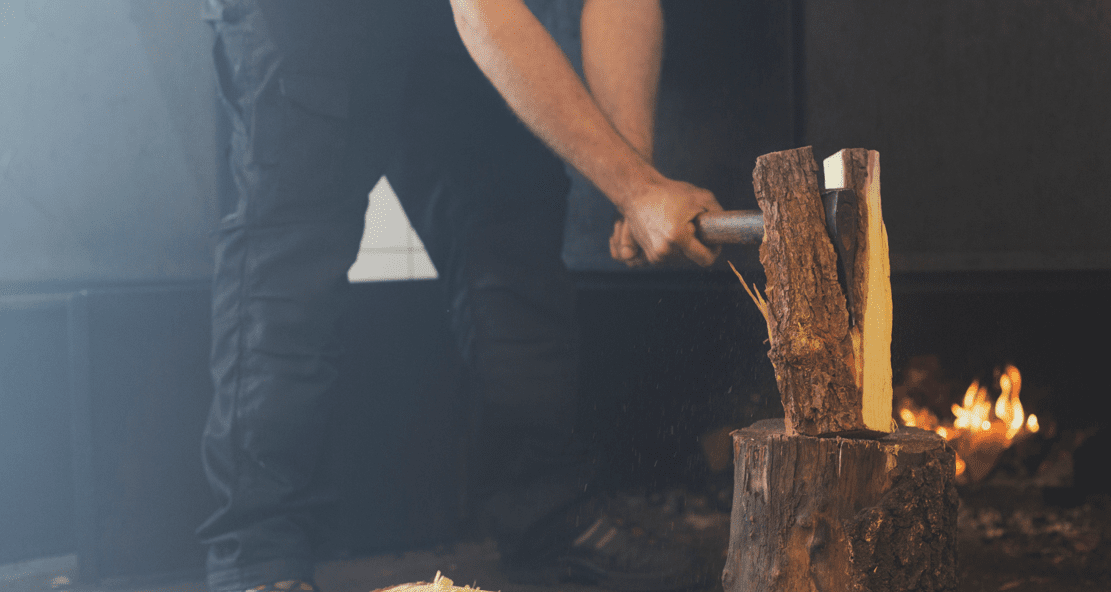
Before chopping away, remember that it’s not all about brute strength when wielding an axe or hatchet. It’s more about precision and consistency in the beginning before that becomes second nature. Can you expect to throw nothing but strikes as a beginning pitcher in baseball? Of course not, and using these tools is a skill that needs practice and development.
Training will allow you to become more precise so you aren’t chopping randomly and creating more work for yourself. Because you’re using two arms to aim the axe, it gives you much more accuracy with a targeted approach.
The power is unparalleled compared to hatchets, but the output will depend solely on your physical strength. That’s why this tool takes time to get better and increase your accuracy.
Physical Fatigue
One of the apparent challenges includes the physical energy required in any given task, and chopping down a tree is much harder than it looks with an axe or hatchet. Chopping can be a great workout, but it’s important to pace yourself first, or things can get sloppy and even dangerous. Hatchets afford you the luxury of switching arms to let the other rest, but if you’re not confident, it’s best to stick with your dominant arm.
Listen to your body and take on more minor challenges while honing your chops. Even if you get used to a particular method like chopping firewood while swinging overhead, you’ll still get incredibly fatigued when transitioning to the lateral swings involved in felling a tree. After all, you’re working out different muscles and approaching the strike from a new angle that requires adaptation.
Hand-Eye Coordination
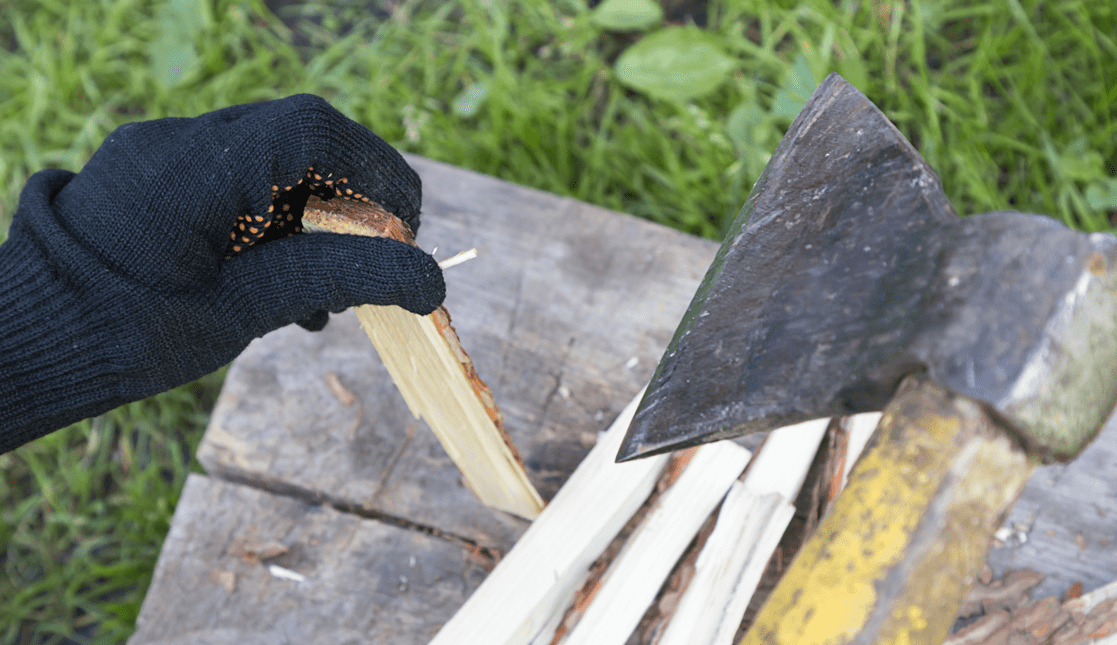
You gain increased endurance, accuracy, and consistency with time and practice. The eyes are critical when using an axe or hatchet to chop wood, and coordination will improve with experience. There are also challenges associated with maintaining your tools and wearing the proper safety equipment while chopping wood.
There’s nothing more rewarding than when you get the hang of splitting wood with ease and enjoy the fruit of your labor with a warm campfire.
The Nature Of An Axe
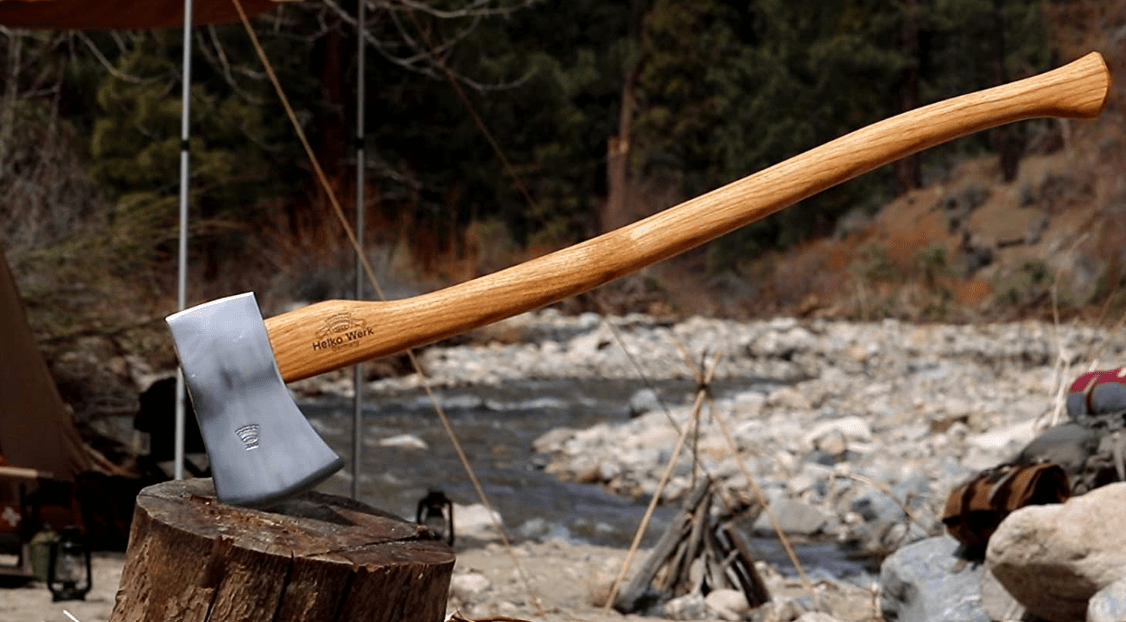
The nature of an axe includes raw power with the ability to chop the most resilient wood and streamline your woodworking endeavors. The traditional way requires immense control and precision while getting your daily cardio in. You’ll appreciate the physical aspects of hard work while using an axe, but that doesn’t mean you have to settle for a lesser model.
Modern axes are much more refined than their ancestors from the stone age and can easily cut through the most daunting wood. Still, chopping a full tree down requires consistent and relentless effort because it is much more resilient when alive and not dried out like firewood. An axe is a versatile tool in woodworking that is considered a classic staple.
What An Axe Is Used For
Here are some of the common uses for Axes:
- Felling Larger Trees
- Splitting logs for firewood
- Hewing
- Carving
- Survival purposes
- Log-building
- Clearing a campground
The Nature Of A Hatchet
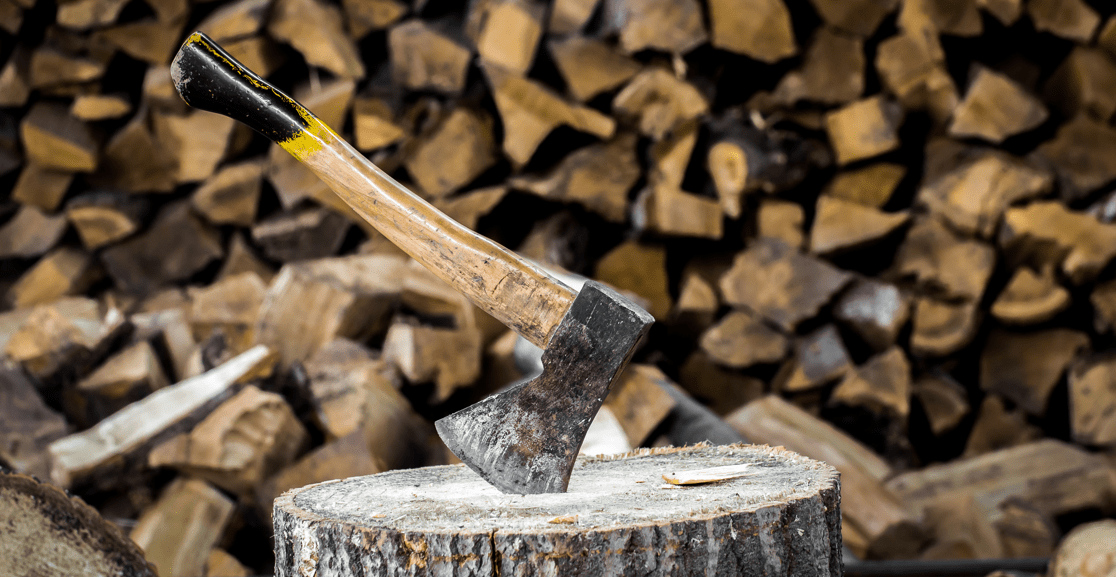
A Hatchet is like the little brother of an Axe, but some come with a hammer side for dual purposes. A hatchet is used for minor wood chopping tasks, including smaller trees and firewood. It is considered a single-handed tool, so that is the proper way to use it when working. You wouldn’t want to use a hatchet with two hands because that would be overkill and the wrong strategy.
It effectively cuts through the smaller branches without as much physical exertion and saves you time. Hatchets are also used in sporting events by throwing them at targets in a safe and controlled environment. It is also known as the “Hand-axe” and can be utilized for hewing like the axe. It essentially serves the same function on a smaller scale for less vigorous chopping.
What A Hatchet Is Used For
Here are some of the common uses for Hatchets:
- Splitting Kindling
- Making Tinder
- Hammering Tent stakes
- Precise Carving
- Chopping small trees
- Ice & Snow Tool
- Cleaning up Limbs
- Processing wild game
Pros & Cons Of An Axe
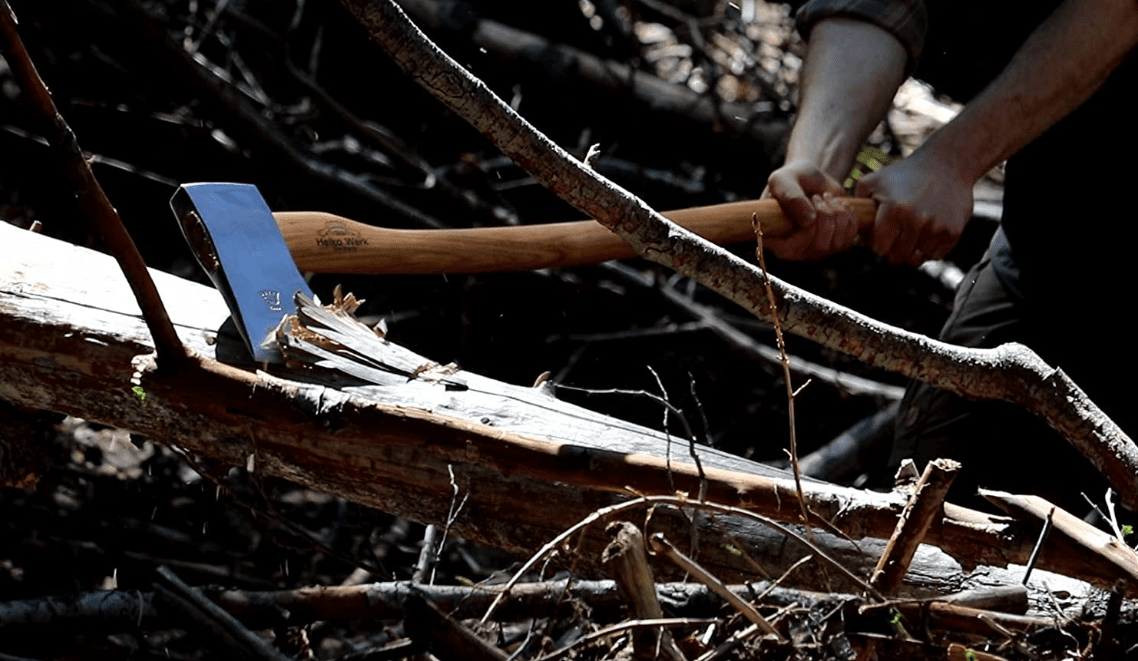
Pros
- Heavy Duty Capability
- Fantastic power with more leverage
- Easier to split larger logs
- Easier to cut down large live trees
- Stable handling for large jobs
- Increased accuracy & control compared to a hatchet
Cons
- Very tiring, especially for smaller people
- Highly repetitive
- Shock can hurt your hands and arms
- It takes time to master accuracy
- Can be dangerous to yourself and others
- They will be more pricey
Pros & Cons Of A Hatchet
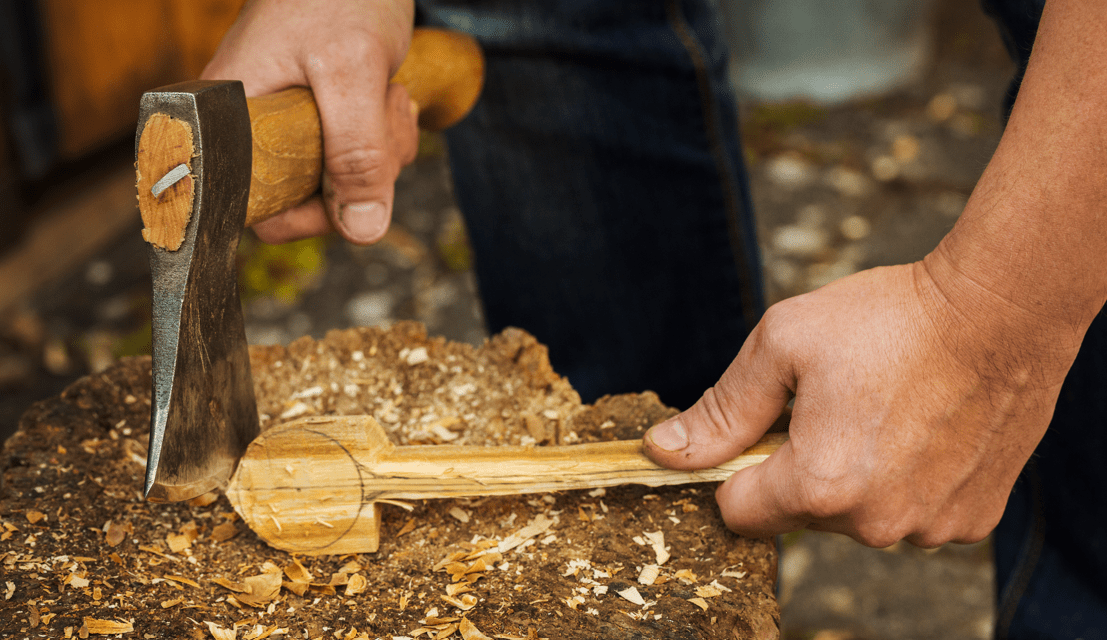
Pros
- Lightweight
- Easier to use
- Makes quick work of small branches
- Highly versatile
- It takes up less space
- Usually, more features available like a nail remover or hammer
Cons
- Struggles with more robust tasks
- More chance of it slipping from your hand
- Limited to one hand
- The downward force is severely limited
- Cutting down large trees is possible but incredibly hard
Things To Consider When Buying
So you’re about to spend your precious money on a hatchet or axe? Well, there are some things you need to consider before settling on the first option that appears in your search. First, you have to know how vigorous your project is.
The higher quality product you purchase, the better results you’ll get; this is a general rule of thumb with any tool. Some axes and hatchets use optimal materials and even come with interchangeable heads.
Carving through the details before buying will ensure the final result is worth your investment. Longevity and endurance are both essential because it’s a repetitive impact that inevitably makes the tool weaker over time.
It’s better to buy something more reliable than settling on a duller blade with cheap materials. Here are some things to consider when shopping for your next axe or hatchet!
Head Shape
Axes and hatchets are very different regarding their head shapes, and you generally won’t find an axe with a hammer on the other side. However, you may find double bladed axes. A tried and true axe isn’t intended to hammer anything and focuses its energy solely on chopping through the wood. Hatchet heads are more narrow and have a large blade for cutting efficiently against the grain.
The head of an axe is thicker and is designed to be more effective in cutting through larger trees or logs. There are many axe head shapes for various purposes, like sharp and thin for felling or specialized heads firefighters use to chop through doors quicker. Determine your needs before settling on a particular head shape, and you’ll be ready to cut through the challenges.
Handle Material
The most common material on the market for axe handles is hickory, a reliable choice. It is affordable, robust, and classic to the American tradition of axe-crafting. However, it might not be the most aesthetically pleasing and tends to suffer brittle consequences during extreme weather. Oak is another viable and robust material with a darker appeal at an affordable price and the ability to absorb shock when handled masterfully.
It is also highly resistant to environmental factors like termites and fungi. Be advised that oak handles have been known to cause splinters if not adequately maintained. A less common material is yellow birch wood, probably because it’s more expensive.
This wood is highly durable and strong while significantly reducing the chance of shattering. It also has high shock absorption while reducing overall fatigue associated with repetitive movements. It’s much harder to get in the USA, but it is worth finding for better performance and longevity. The handle material is significant when shopping, especially if you want to reduce the chance of breakage.
Interesting Read: How Does Birch compare to Aspen Wood?
Head Weight
Head weight is one of the more significant differences with an axe being up to three times the weight of a hatchet’s head. This is something to consider when making your decision between the two. It’s probably better to shop in person for an axe to see if it will be problematic.
Each person has a different range of strength, and a hatchet might be the best option. Some axe heads are lighter than others, which can be more encouraging for the novice wood chopper. Remember that a hatchet weighs around six times less than a traditional axe, which is a remarkable difference. An axe’s weight is the head, which gives you that impressive leverage when swinging overhead.
Shaft Length
The shaft length of a hatchet is much shorter than an axe, so it’s easier to transport and store. This comes at the cost of reduced power and potential when addressing more daunting timber challenges. The shaft length is significant to consider based on what your intent is.
For example, if you aspire to cut down a fully grown tree in the forest, then the longer shaft of an axe is far more appropriate unless you want to sweat bullets and wonder why things aren’t going well. Consider what angles you’ll need to execute, and it will become apparent which is necessary for your needs.
Portability
Choosing a hatchet is preferable if you don’t want to lug a heavy axe around for miles. However, you should have a good idea of what work needs to be accomplished. Even if an axe is difficult to carry and store, it evens out when you need it to perform more significant tasks efficiently. If you’re camping, it’s generally ideal for holding a hatchet, which can be conveniently holstered at your side and hiked across long distances to clear stray branches.
If you try to carry a heavy axe around in that manner, you’ll be too tired to chop anything because of the sheer weight. It will constantly bump your legs if you attempt to secure it at the waist. Axes are not suitable for traveling purposes and are best used in a fixed location. Hatchets are much more convenient and portable options, without a doubt!
Shaft Design
You’ll commonly find durable metal handles with hatchets, but with axes, the shafts will almost always be wooden. A hatchet shaft usually is curved forward for more efficiency, whereas an axe will be at a 90-degree angle. Some shaft designs are more ergonomic and may have a grip for increased handling and stability.
This naturally translates to higher accuracy and can make it easier if you’re a beginner. Human hands are different sizes, and what works for someone else might feel awkward to you. First and foremost, you should settle for a comfortable design to feel confident in the field.
Why You Need An Axe
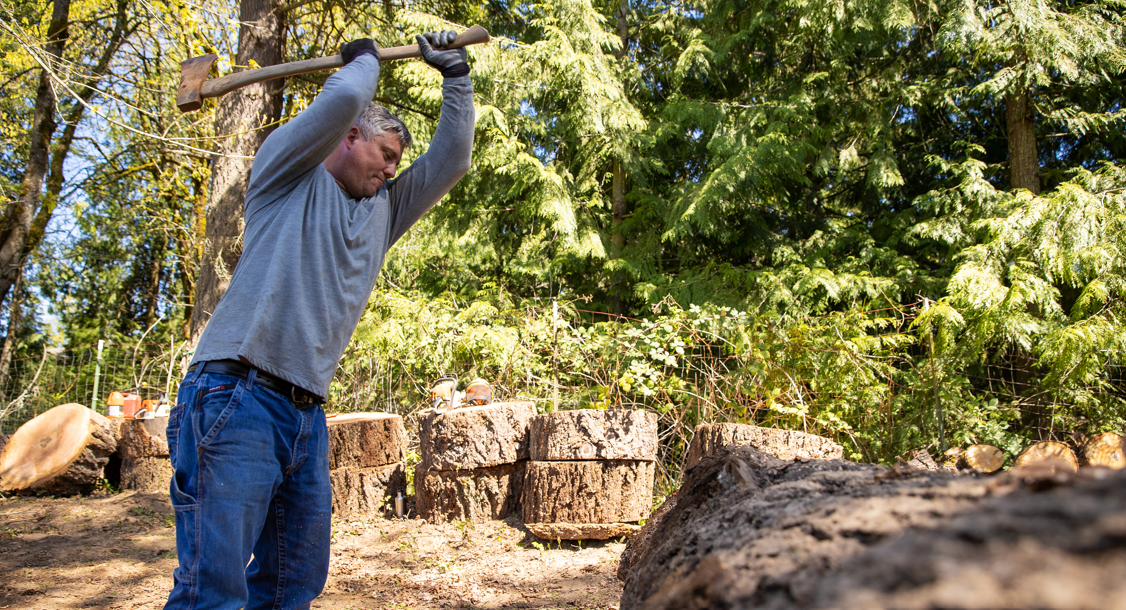
First, you might need an axe for survival purposes, and no tool’s more versatile. You can start chopping wood to build a structure in the wild to protect you from the elements. It’s also imperative to stay warm in the winter, which requires attaining firewood quickly.
Additionally, an axe can effectively scare wild animals away and give you a weapon to defend yourself if one attacks. Remember that some axes are built explicitly for survival with a slightly thinner blade.
Another reason you need an axe could be for simple camping where you can quickly confront otherwise tricky tasks. These include chopping firewood and even carving a fishing spear. Chopping firewood for your home fireplace is a great way to stay in shape and has been shown to burn around five hundred calories per hour.
You can skip the gym if you’ve been chopping wood regularly because it works out multiple muscle groups. An Axe makes working with wood more manageable, and it’s gratifying when you start sweet-spotting the logs for the perfect split.
Axes are the powerhouses of the woodworking world, and they give you a sense of accomplishment and a feeling of readiness against the challenges of nature. Some lesser utilized benefits of owning an axe might include climbing and digging. It aids in clearing a campground quickly so you can get a clearer picture and establish your territory.
Another reason you should own an axe is its aesthetic beauty and legendary historic appearance. You naturally feel more prepared and confident when holding an axe because it opens the door to new possibilities in nature. It even makes for a rustic decorative piece.
Why You Need A Hatchet
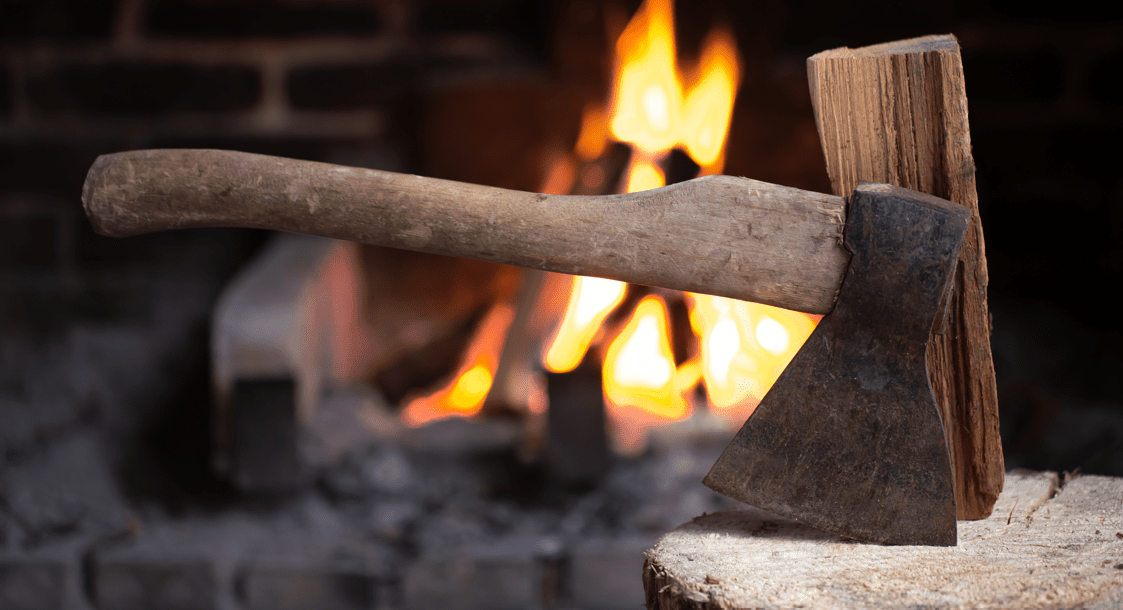
A hatchet is perfect if you regularly split more minor pieces of wood or clear pesky branches on a trail. You need a hatchet for cleaving carcasses and processing animals with greater precision than an axe could ever accomplish. Hatchets are much better for setting up your campsite and have more versatility than axes. If you’re camping, it will help you quickly chop down some branches for the fire without breaking much of a sweat compared to an axe.
They are excellent for debarking a tree and clearing a path with the excess brush. Believe it or not, some men also use a hatchet to shave, but this requires a steady hand and a lighter model. Wood carving is also a fun hobby, and hatchets give you precision and the ability to carve wood better.
Look for a hatchet with a carving head, and you can craft bowls and spoons to use in the wild for an exciting and rewarding natural approach to survival. They can aid you significantly in food prep by serving the same function as a knife. A hatchet is especially beneficial while fishing because it can shave the scales and gut fish quickly without other tools.
A hatchet is the first tool you should purchase if you’re into bushcraft. It’s the best for keeping you alive in unrelenting conditions and can help you practice for a worst-case scenario. You can practice making some DIY furniture in the wild, which can become a worthwhile hobby. Anything that aids in survival is worth having, and any true survivalist wouldn’t be caught dead without a trusty hatchet at their side.
Proper & Safe Handling Of An Axe
The first rule to remember when using an axe is considering the reach while establishing a safety circle. People should be aware that you’re engaging in axe work, so there aren’t any accidents. Proper clothing is suggested so that nothing loose inhibits the swinging motion. Additionally, an axe will cut right through the leather of your shoes and into your foot if you’re not careful.
Steel-toed boots are ideal when working with an axe. Never swing an axe in the dark because you can’t see what’s happening, which increases the risk of injury. Make sure to listen to your body after a long day chopping wood. If you’re feeling fatigued, then don’t push through for the sake of getting the job done. Splitting firewood is much safer when using the appropriate flat chopping block. It protects both you and the axe blade while engaging in repetitive chopping.
Rest is much better than an Axeiddent, (pun intended.) An axe is not a toy and deserves respect when handled like an adult. Nothing is stopping you from enjoying the work responsibly, though. If you’re working with others, make sure to transition the axe safely. The best option is to leave the axe next to a stump for someone to pick up instead of directly handing it.
Practice proper technique, so you don’t pull something, and inspect the axe before using it, so it’s sharp and ready without any cracks or deformities. Remember that an axe is different than a hatchet and requires a wider stance and a chop block for safety and consistency. Wearing goggles is also critical to prevent shards of wood from flying into your eyes.
Gloves can also help reduce the shock and increase your control. The handle should also be inspected for cracks because this is where much of the force affects the axe. Continued usage will cause grease build-up, which should be thoroughly wiped down before handling to maintain a firm grip.
Proper & Safe Handling Of A Hatchet
Hatchets are slightly different regarding safety, but the principles remain the same. Exercise common sense and use it responsibly with respect as you would a firearm. Since they are much lighter, it might be tempting to hack away and increase the speed with a hatchet. While you can go a bit quicker, it should still be a controlled rhythmic movement that’s not sporadic or too fast. Hatchets should be sharpened before use to ensure maximum efficiency and safety.
You might want to test your aim by throwing a hatchet since it’s smaller, but that’s a bad idea, especially if you’re around friends. Throwing hatchets should only be done in the designated safe areas under the sport’s guidelines.
It’s best to avoid cutting down a large tree with a hatchet. If it’s a younger tree, that’s possible; otherwise, it’s just a waste of effort and a misuse of the tool. You’ll likely get too exhausted to finish the job, and it’s better to use an axe instead.
Always keep your hatchet sheathed when not in use. You should never carry a hatchet unsheathed while walking around, and it should be securely fastened to your backpack or survival belt.
Alternative Tools To Consider
1. Table Saw

An electric table saw can cut through large blocks of wood or logs without a sweat. They are generally more expensive, but it’s a wise investment if you’re older and have a bad back.
Using an axe all day is a younger man’s game, and the weight is simply too much for some. A table saw gives you more precision and allows you to monitor the process more efficiently. The main benefit is undoubtedly the increased speed of the operation.
Smaller planks can be cut quicker than an axe and with more precision. It would suit projects like cutting out fence posts that must be meticulously even. It can easily cut through the most stubborn woods, so you save time and energy.
It’s certainly a valuable alternative to an axe in your workshop. They are widely used for furniture and professional woodworking for other products.
2. Hydraulic Log Splitter
A hydraulic log splitter is another option you might like to consider to split logs for firewood easily. They apply tons of wood-splitting force to accomplish any cut. They are easy to operate and give you a sense of power and control from start to finish.
This is an ideal tool if you’re looking for more precision and saving physical energy. Cutting down on your physical labor is essential when working with larger projects, and a hydraulic log splitter will make it more viable for the long term.
3. Gas/electric Chainsaw
A chainsaw is a classic tool for cutting down stubbornly large trees and dealing with thick logs. You can get them in gas or electric options; they do an excellent job cutting through wood. You must wear eye protection while using one, and they’re more dangerous than the traditional axe approach.
Cutting down multiple trees with a simple axe would be foolish if you’re working on a large-scale operation. That’s where a chainsaw comes into play with unparalleled machine efficiency!
Frequently Asked Questions
Question: Why are some axes double-sided?
Answer: Double-sided axes are helpful because they allow you to chop more evenly on either side of the axe head, resulting in higher efficiency. It makes the process much easier and gives you more consistency and longevity. It is heavier but more balanced when swinging.
Question: Should I buy an axe or hatchet when camping?
Answer: For the most part, a hatchet is your best option for camping because of its portability and versatility when setting up camp. Some hand-axes are specifically designed for camping and might be better than your traditional hatchet.
Question: Which is the best option for general yard work?
Answer: This will depend on your yard, but most tasks can be accomplished with a simple hatchet. For example, if a storm knocks down some branches, you can easily cut them up to throw away with a hatchet instead of a heavier axe. Hatchets can also be used to cut through brush in a garden to clear for the next season.
Question: Do I need to sharpen my axe and hatchet?
Answer: Ideally, you should inspect your axe or hatchet before using it to make sure they are sharp and sturdy. It’s good to sharpen before each task to stay safe and efficient. A dull blade can be dangerous and make you tired quicker. You’ll be able to feel if an edge isn’t working correctly because of the sharp contrast to a brand-new axe or hatchet.
Conclusion: Your Toolset Will Benefit From Having An Axe & Hatchet
Should you buy an axe or a hatchet? I suggest you purchase two of each if you take woodworking seriously. It doesn’t seem that necessary until it becomes relevant, and one will be superior to the other in differing circumstances. They are both exquisite classic woodworking tools that have evolved to a higher state of greatness. Having a spare of each in your workshop is the best choice if you desire a well-rounded toolset.
The best way to learn is through chopping experience with different heads. Each tool has a unique feel, and you’ll understand the trade better with a hands-on approach. Focus with intent and consider using it your first time with a more experienced person who can guide you in the proper technique. They can also point out some mistakes you might not be aware of and cause you to make immediate adjustments.
While distinct variants exist, such as the camping axe and other exciting blades, a you may want a general, all-encompassing product if you’re unsure how you’ll use it. Axes and hatchets will help you feel more equipped in the wilderness or at-home settings.
They prepare you for nature’s surprises and help you manage your yard better. Both are ideal for keeping handy because of their significant benefits, but it requires responsibility and active maintenance to keep them functioning well!






